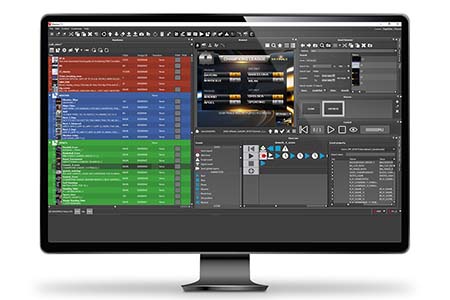Avid has announced that more than one million users in nearly every country have downloaded Avid First creative tools for free, including Pro Tools | First, Media Composer | First and Sibelius | First.
 Avid has announced that more than one million users in nearly every country have downloaded Avid First creative tools for free, including Pro Tools | First, Media Composer | First and Sibelius | First.
Avid has announced that more than one million users in nearly every country have downloaded Avid First creative tools for free, including Pro Tools | First, Media Composer | First and Sibelius | First.
Avids family of First tools includes product features and capabilities available in the professional-grade Avid offerings. With Avid s First tools, creatives also gain access to the world of Avids online artist Community.
Commenting on his use of the Avid solutions, John Ashton Thomas, Orchestrator for Black Panther said:”I use Sibelius on every single project I work on in film, concert music, and production music. Sibelius | First makes the essential tools I use every day available for everyone for free.
Scott Jacobs, Assistant Editor, Despicable Me 3, The Bourne Legacy, added: Knowing Media Composer is integral to our job because if you want to work in Hollywood, 90 percent of the films being made are being edited by using Avid.
Jeff Rosica, Avid CEO and President, stated: Hit TV shows, chart-topping music, and blockbuster films come from celebrated creative minds who are telling amazing stories with help from Avids creative tools. By getting the tools the pros use into the hands of more than a million beginners around the world, Avids fostering a whole new generation of content creators who will grow to delight and inspire audiences everywhere.
Also at IBC 2018, Avid announced the launch of the next generation Maestro | Engine real-time graphics and video hardware rendering platform for its Maestro Graphics product line. Maestro | Engine scales from HD and 1080P to UHD supporting both SDI and Video Over IP interfaces. With Maestro | Engine, broadcasters can reportedly produce graphics, virtual studios, augmented reality and video wall content in the industrys highest achievable quality.
As the successor to Avid HDVG, Maestro | Engine enables broadcasters to introduce new production capabilitiesincluding 3G, UHD, HDR, and IP workflowsalongside their current HD/SD SDI workflows. Available in two configurationsMaestro | Engine and Maestro | Engine 4Kthe platform works with all Maestro graphics suite solutions, providing performance, scalability, and format support.
Commenting on the innovation, Ray Thompson, Director of Broadcast and Media Solutions Marketing at Avid, said: As broadcast production evolves, broadcasters increasingly need flexible, future-proof graphics rendering hardware to enable them to tell more compelling stories. The new Maestro | Engine enables customers to differentiate and elevate their content with compelling data-driven augmented reality graphics and virtual sets delivered in real time. Maestro | Engine hardware supports IP I/O and delivers the performance and reliability required for any news, sports, or other broadcast content engaging audiences in new ways.
Maestro | Engine is available in two hardware configurations that can be scaled for any production need. The Maestro | Engine base system offers up to eight video insertions and up to four outputs, including fill and key, to handle most standard CG needs and dual channel production. To tackle more demanding UHD, video wall, and virtual studio productions, Maestro | Engine 4K offers up to 16 video insertions and up to eight outputsor up to four fill and four key outputs for UHD production.
Maestro | Engine works across all Maestro graphics suite authoring and control solutions both new and old, providing backwards compatibility so existing content and production will continue to work.
Maestro | Engine works in concert with Maestro | RenderEngine software, providing advanced graphics rendering. It also can drive content to multiple canvases, scale content up or down, and crop it. This makes it easy to preview large-scale video walls with a single HD feed.
To elevate virtual studio productions to cinematic quality, Maestro | Engine 4K works with both Maestro | RenderEngine and Epics Unreal Engine. Users get the power and flexibility to present stunning virtual environments full of realism, depth, and detail. Because only Avid engines can run simultaneously on a single Maestro | Engine 4K, users can render all virtual studio elements using Unreal Engine while overlaying data-driven augmented reality graphics with Maestro | RenderEngine.
Featuring a proprietary I/O card that delivers ultra-low-latency video transfer, Maestro | Engine maintains a constant two frames of delay from input to output for seamless object mapping and audio handling. The Maestro | Engine is also capable of real-time graphics, video compositing and rendering, with scalable inputs, fill and key outputs. Its open API enables users to create their own control applications.
Maestro | Engine handles live video sources and plays back video stored on its local drive, Avid NEXIS, or other network storage device. It has two 1GbE connections and a 10GbE option for more demanding video transfers. Users can create compelling visuals using video clips as background elements or as textures mapped onto scene objects. Maestro | Engine supports a wide range of codecsincluding Avid DNxHD/DNxHR, XDCAM 50, AVC-I, XAVC-I, and QT RLE.
Users dont reportedly need to install additional client software or have a systems administrator tethered to the machine room to manage and configure settings. Maestro | Engine uses a web-based interface for all systems management. Users can set up and make changes to access rights, video formats, genlock sources, input and output mapping, and other settings from any computer or device on their networkfrom anywhere.
Maestro | Engine and Maestro | Engine 4K will ship in the fourth quarter of 2018.
















































































